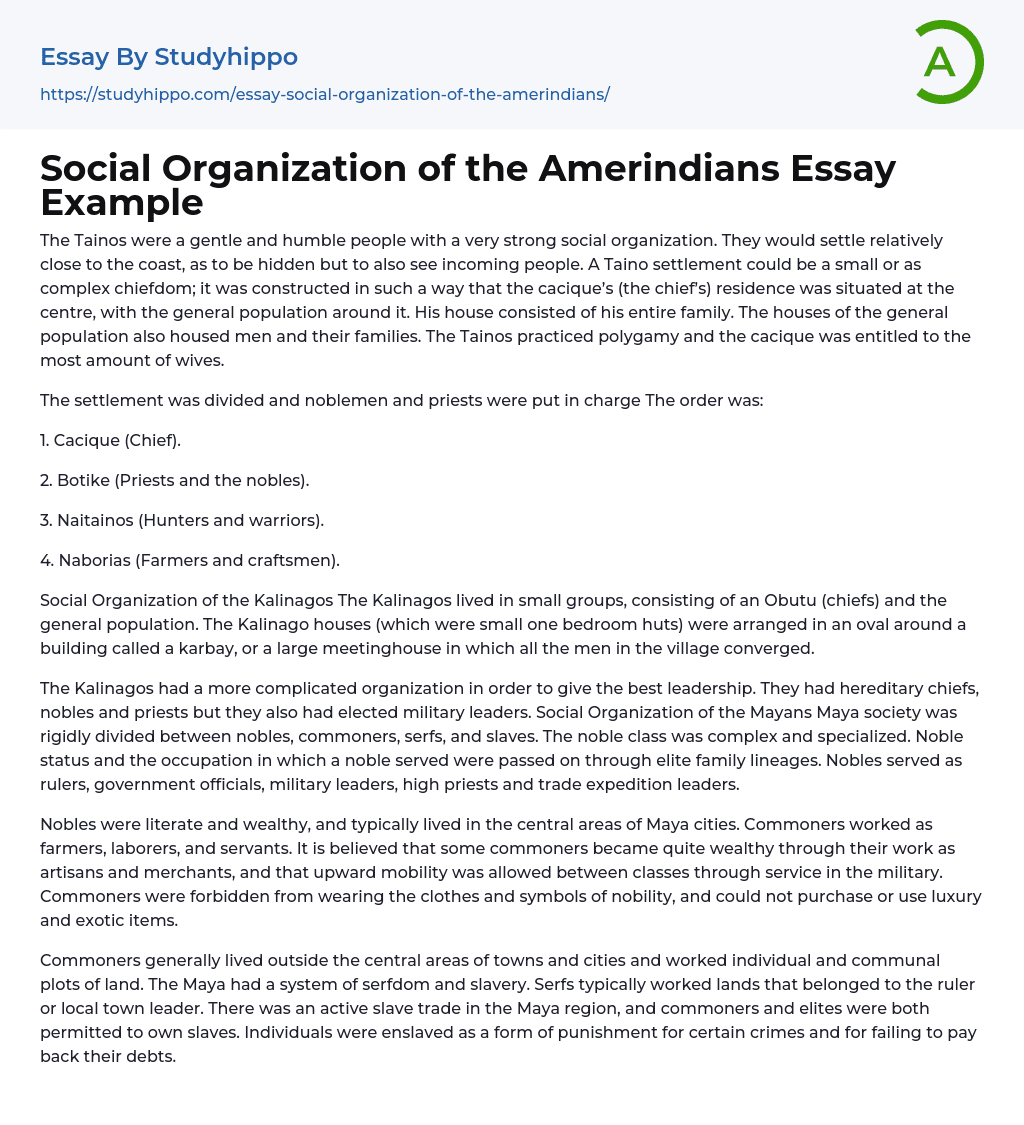The Tainos were a gentle and humble people with a very strong social organization. They would settle relatively close to the coast, as to be hidden but to also see incoming people. A Taino settlement could be a small or as complex chiefdom; it was constructed in such a way that the cacique’s (the chief’s) residence was situated at the centre, with the general population around it. His house consisted of his entire family. The houses of the general population also housed men and their families. The Tainos practiced polygamy and the cacique was entitled to the most amount of wives.
The settlement was divided and noblemen and priests were put in charge The order was:
1. Cacique (Chief).
2. Botike (Priests and the nobles).
3. Naitainos (Hunters and warriors).
t-align: justify">4. Naborias (Farmers and craftsmen).
Social Organization of the Kalinagos The Kalinagos lived in small groups, consisting of an Obutu (chiefs) and the general population. The Kalinago houses (which were small one bedroom huts) were arranged in an oval around a building called a karbay, or a large meetinghouse in which all the men in the village converged.
The Kalinagos had a more complicated organization in order to give the best leadership. They had hereditary chiefs, nobles and priests but they also had elected military leaders. Social Organization of the Mayans Maya society was rigidly divided between nobles, commoners, serfs, and slaves. The noble class was complex and specialized. Noble status and the occupation in which a noble served were passed on through elite family lineages. Nobles served as rulers, government officials, military leaders, high priest
and trade expedition leaders.
Nobles were literate and wealthy, and typically lived in the central areas of Maya cities. Commoners worked as farmers, laborers, and servants. It is believed that some commoners became quite wealthy through their work as artisans and merchants, and that upward mobility was allowed between classes through service in the military. Commoners were forbidden from wearing the clothes and symbols of nobility, and could not purchase or use luxury and exotic items.
Commoners generally lived outside the central areas of towns and cities and worked individual and communal plots of land. The Maya had a system of serfdom and slavery. Serfs typically worked lands that belonged to the ruler or local town leader. There was an active slave trade in the Maya region, and commoners and elites were both permitted to own slaves. Individuals were enslaved as a form of punishment for certain crimes and for failing to pay back their debts.
- Slave Trade essays
- Aesthetics essays
- Art History essays
- Artist essays
- ballet essays
- Body Art essays
- Color essays
- Concert Review essays
- Creativity essays
- Cultural Anthropology essays
- Ethnography essays
- Harlem Renaissance essays
- Heritage essays
- Modernism essays
- Mona Lisa essays
- Pastoral essays
- Postmodernism essays
- Realism essays
- Symbolism essays
- Theatre essays
- Visual Arts essays
- Voice essays
- Work of art essays
- Bangladesh essays
- China essays
- Hong Kong essays
- India essays
- Japan essays
- Kuala Lumpur essays
- Malaysia essays
- Manila essays
- Pakistan essays
- Philippines essays
- Singapore essays
- Vietnam essays
- Vietnamese essays
- Administration essays
- Architect essays
- Discipline essays
- Doctor essays
- Engineer essays
- Farmer essays
- Hunter essays
- Labor essays
- Model essays
- Nurse essays
- Pilot essays
- Police Officer essays
- Professionalism essays
- Social Work essays




